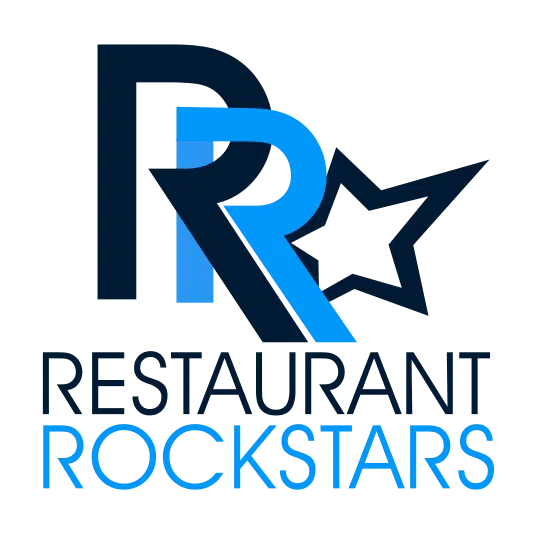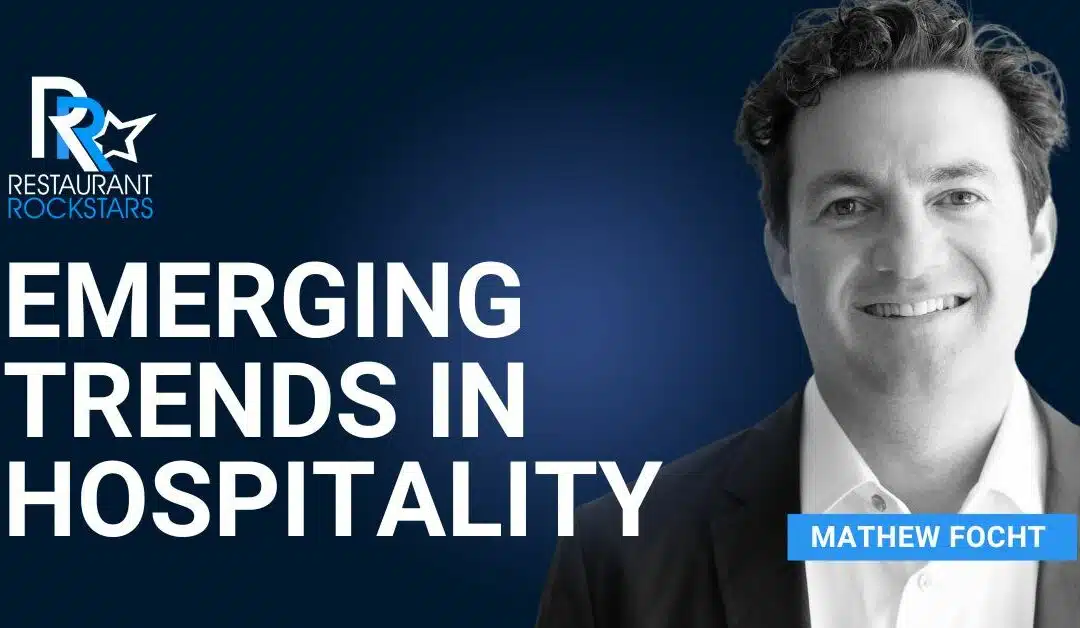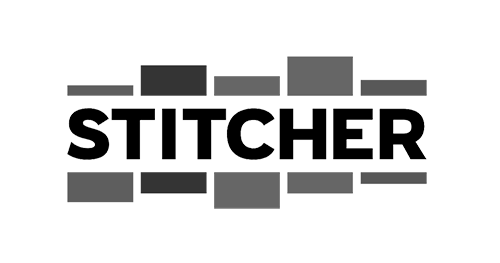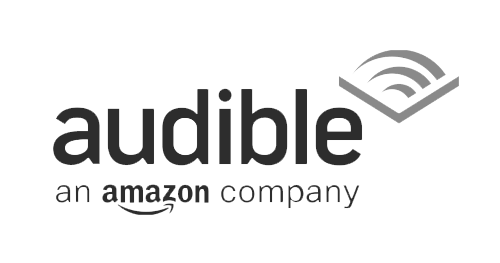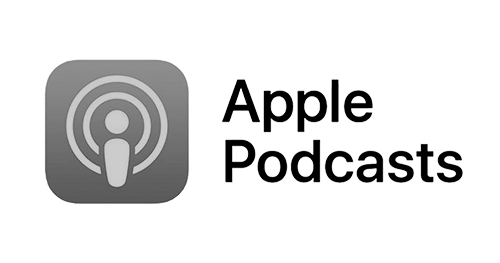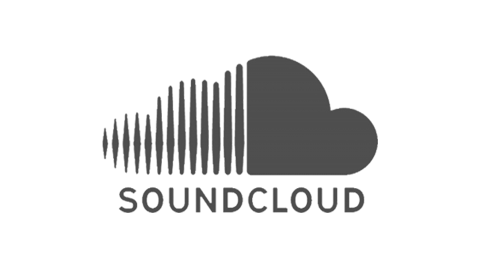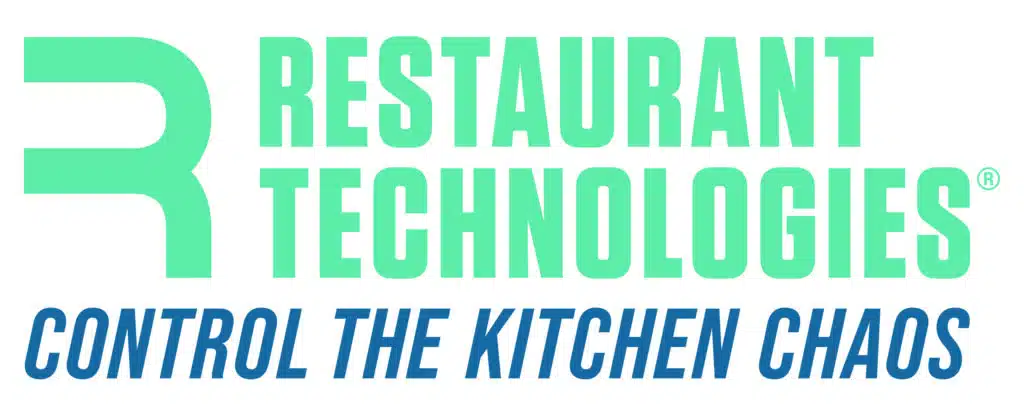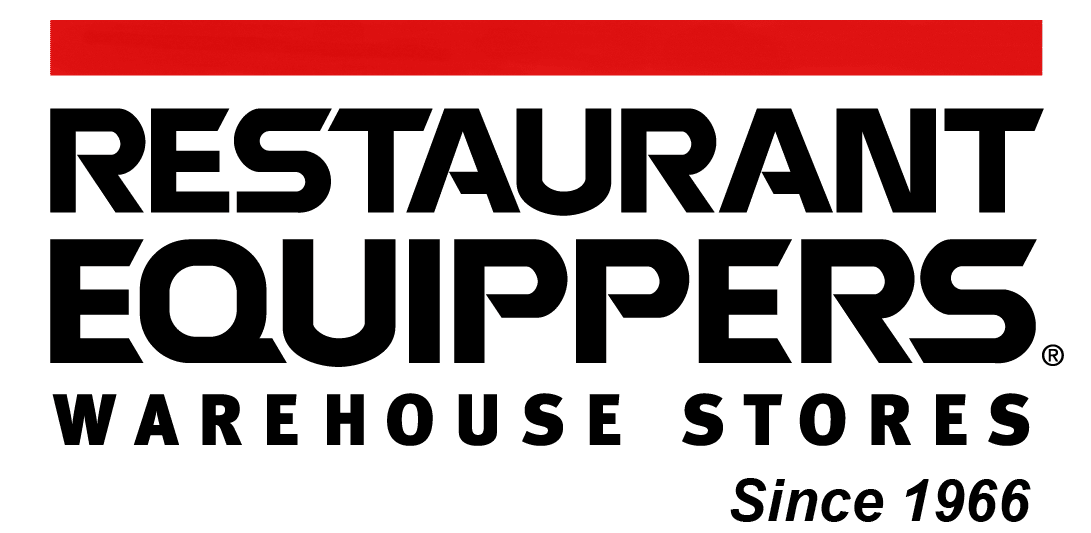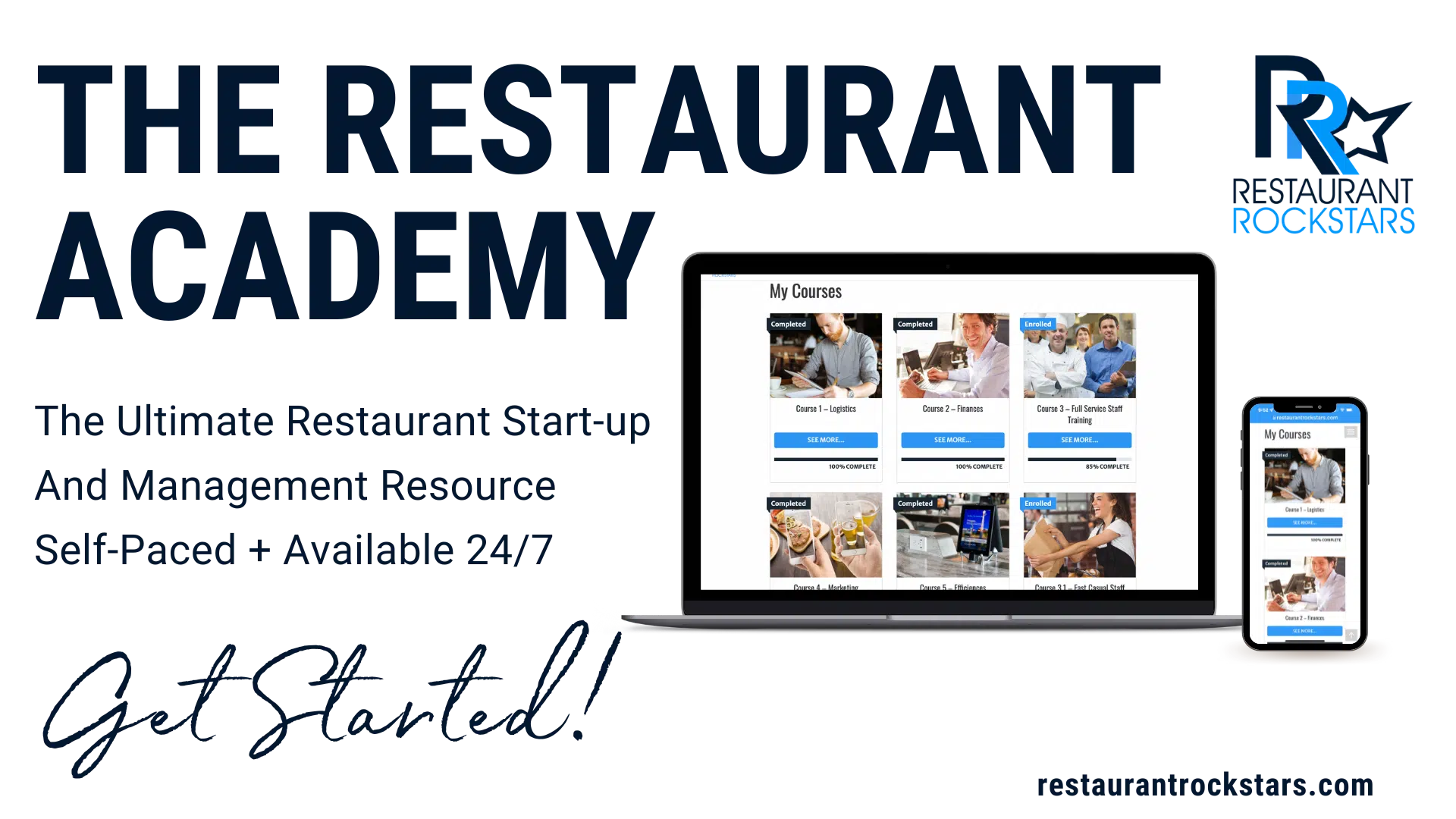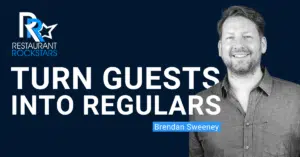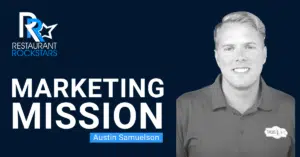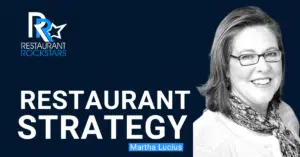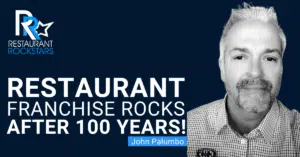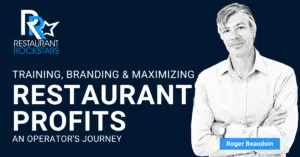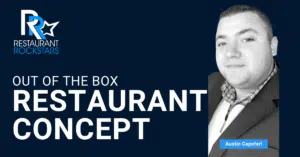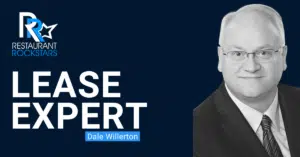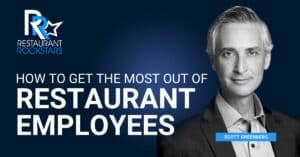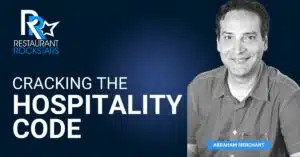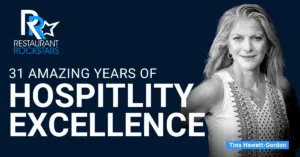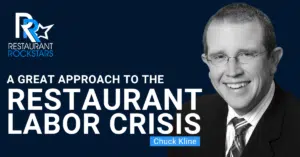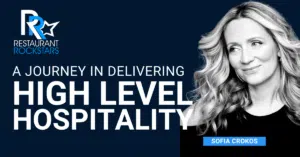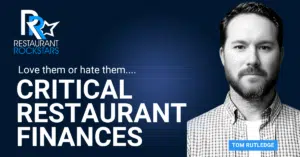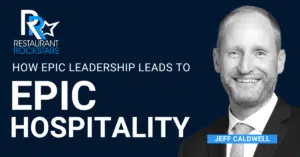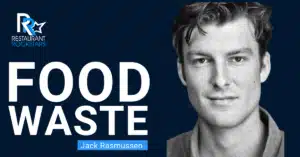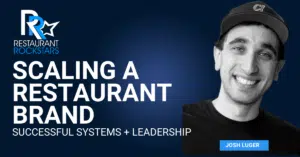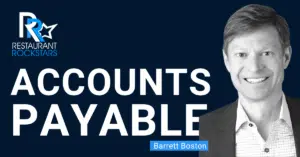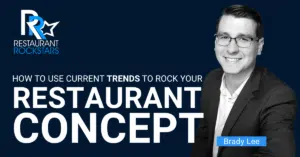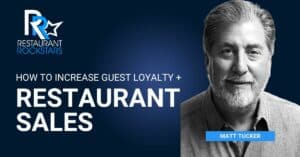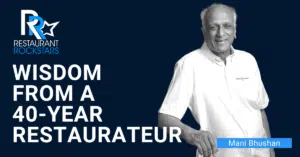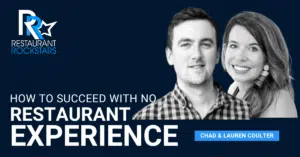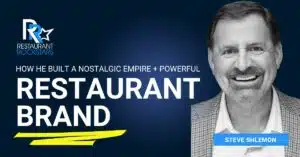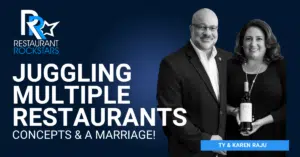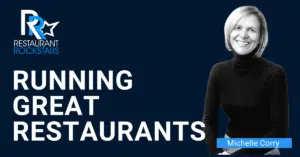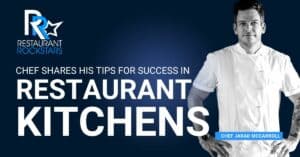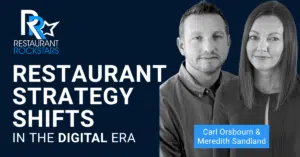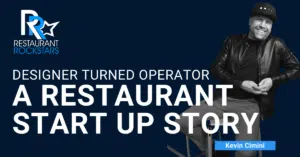Restaurant Rockstars Episode 394
Emerging Trends in Hospitality
LISTEN HERE OR ON YOUR FAVORITE PODCAST PLAYER
Restaurant Success in the hospitality space can be elusive.
You can have a good location, your costs dialed, your staff performing and good food, and still not be filling your seats every day of the week.
What’s the key to a thriving business in hospitality? How can you attain real restaurant success?
In this episode of the Restaurant Rockstars Podcast, I’m speaking with Mathew Focht, the Founder and Managing Partner of Emerging. Emerging is a diversified company and fund that’s investing in the hottest growing industry and restaurant successes. From hot concepts (FlightClub, PuttShack & F1 Arcade) to supply chain to technology, Mathew is a visionary with his finger on the pulse of hospitality.
By focusing on empowering employees and adapting to changing consumer preferences, Matthew offers valuable insights for aspiring restaurateurs and industry veterans alike.
Listen as Mathew shares his passion for hospitality including:
- Strategy, experience and vision to emerging F & B opportunities
- Why “experiential dining” that combines curated food & beverage, superior service and entertainment is a “magic hospitality formula”
- The critical operating systems to scale and grow a winning hospitality company
- The keys to leadership and finding and retaining great staff
- Staying relevant amidst shifting consumer preferences and dining choices
- The leverage and bottom-line impact of buying groups and premium table charges to your restaurant success
We delve into Matthew’s career journey, his work with restaurant operators, and the importance of team execution in scaling restaurant operations.
Key topics include scaling restaurant operations, leadership and empowerment in hospitality, labor challenges, and evolving consumer dining preferences.
Matthew sheds light on the importance of data and technology in optimizing restaurant performance. He also shares insights on emerging trends, such as the role of robotics and tools like Botrista in enhancing guest experiences and increasing revenue.
I visited Emerging’s “experiential” dining concepts in Boston to see the magic formula in action. Great food, great service & great fun!
Tune in to learn about the future of hospitality and restaurant technology! Watch or Listen to this episode then, go Rock YOUR Restaurant!
Roger
Key Topics:
- Matthew’s Hospitality Journey
- Scaling a Restaurant Business
- Leadership and Team Building
- Inflation and Consumer Behavior
- Trends in Hospitality & Dining Experiences
- Balancing Throughput and Revenue
- Emerging Concepts and Investments
- Buyer’s Edge Platform Overview
- Exploring Social Entertainment Concepts
- Miniature Golf Business Insights
- The Rise of Putt Shack
- F1 Arcade: A New Era in Social Entertainment
- The Importance of Service and Experience in Hospitality
- Maximizing Customer Throughput
- Innovative Marketing Strategies
- Leveraging Data for Restaurant Success
- Dynamic Pricing with Tables
- Botrista: Revolutionizing Non-Alcoholic Beverages
- The Future of Robotics in Restaurants
Connect with our guest:
https://www.instagram.com/EmergingFeed/
Thanks for joining me on the podcast. Today’s guest, Mr. Mathew Focht , is the CEO of Emerging, a really diverse hospitality company that’s in investing in supply chain, in really hot, fast growing concepts, as well as technology. Everything that’s happening and trending, and even the things that are yet to come, they’re involved in.
So it’s a really fascinating conversation and we’re going to talk about what is the foundational elements of really successful restaurants. And we’re going to talk about, , key performance indicators and financial performance and building leadership and teams. And how do you really grow a concept from one to multiple and then scale it?
What are the necessary elements there? So we cover a lot of ground. You’re not going to want to miss this episode. If you haven’t already heard, I have a course called The Restaurant Profit Maximizer. And it’s literally teaching you the biggest needle movers that are really going to make an impact in your business.
Bottom line, it’s a short course. It’s about 40 minutes. It’s a video you watch and you can immediately action some of these ideas to increase your profits multiple ways. Now the best part about it is it’s, geez, less than the cost of a craft beer or a fancy coffee. Yep, just seven bucks. So head on over to restaurantrockstars.com/profitmaximizer and check that out. Now on with the episode.
You’re tuned in to the Restaurant Rockstars Podcast. Powerful ideas to rock your restaurant. Here’s your host, Roger Beaudoin.
Rockstars, in my restaurants the fried foods were cranking out of the kitchen, but dealing with the fryer oil and cleaning hoods from all that grease, what a hassle. Not only the high cost, but the mess of changing and recycling oil, scheduling cleanings, you’ve got more important things to run a great restaurant.
Well, that’s where Restaurant Technologies comes in. They serve 40,000 restaurant and hospitality customers in 41 major markets across the U. S. They handle everything, end to end, from delivering, filtering, monitoring, collecting, and recycling your waste cooking oil. No more mess, safety hazards, workers comp claims, or fried food quality issues.
Plus, this frees up your labor, and the cost, to work on what matters putting out the best food. Restaurant Technologies also eliminates the need for scheduling third party hood cleanings. AutoMist can reduce the risk of fire with automated hood and flue cleaning, hassle free. Restaurant Technologies customers can save 10-15 percent on their insurance premiums and even get bonuses for any new customer referrals.
Control the kitchen chaos with Restaurant Technologies. Go to rti-inc.com or call 866-399-3639 to get started today.
Welcome back, everyone. This is the Restaurant Rockstars podcast. So glad you’re here. And Mathew, welcome to the show. Glad you’re with us.
Yeah, it’s great to be with you. Thank you.
You got a really dynamic background. Now we’re going to dive into Emerging and what it’s all about. But before we do, tell us about your hospitality story and why you’ve got a passion for this business.
Yeah. Yeah. It’s interesting. I grew up in a small town in Ohio on a, a, basically a boating town. There was more boats than people, 42,000 boats in a town of 10,000 people. So it was, hospitality became a big part. It was all food and beverage. And I went to engineering school in Cincinnati.
And I thought I wanted to be a master plan developer, community developer because it was those town squares that had that kind of that small town, that feel that I had as a young kid getting on the bike and going anywhere in town. And I saw the master plan developers at the time my Toll brothers I accepted the job out of my engineering school, my MBA with Toll Brothers in Fairfax, Virginia.
And then I saw this developer in Columbus, Ohio. We’re called Steiner Associates, who is building Easton Town Center, 1200 acres, and it was the restaurants and entertainment that were the lifeblood of this development. The town square, beautiful Brio. I was sitting on the square at Cheesecake Factory, all these chains you’d think of today, but there, they were, they were driving the traffic and it wasn’t the traditional department store anymore.
So I fell in love with restaurant operators early on. They were more. Quirky, entrepreneurial, scrappy, more interesting than the retail guys that live in life define the entrepreneurial American dream in a lot of ways. I find the restaurant guys doing that.
So I just started helping them, supporting them, using the engineering hat kind of a data. approach and then ultimately that data approach of supporting them in real estate expansion led to me to get in some rooms I probably didn’t deserve to be in at a young age, but ultimately leading to strategy on a national level with a bunch of great operators.
It is definitely a business of passion, and there’s every facet of hospitality out there, and you’ve got your, you got your hands on the pulse of so much of it, and I really can’t wait to dive in, because I had a chance to visit some of your concepts that you’re invested in, and there’s definitely a magic formula there, but I believe systems are foundational.
In order to scale a business, what are your thoughts on, taking a single location, you might have had success in that single location, whether it’s the concept or the cuisine or whatever it is. And most owners or operators will think, Hey, if it works here, it’ll work there. It’ll work in that town, this city, whatever.
But it takes a lot more than just having a thought of, I got one successful place. What’s your best advice on scaling an operation and growing it three to five to 10 and even bigger, if that’s what your dream is.
Yeah, that’s a good question, Roger. I, really, at the end of the day, as much as you might have the magic of the concept, you might have the menu that you think is perfect, you have the atmosphere that is vibrant, and just everybody wants to rave about and visit it really comes down to the team and execution.
You, I find awesome concepts that you would swear were just going to crush it nationally and ultimately, They fall short, or they, another team with an inferior, I think, experience finds them, executes so much better and builds scale so much faster because it’s, it comes down to the team, not necessarily the atmosphere, the menu.
So I think we all know that it’s, everybody’s talked about the team, but it’s really about getting, making sure you have a team that really is gritty and wants to, Really grind it out and passionate about building a brand, traveling and making sure they’re finding those sites and building their complimentary partners, that are going to work those late nights.
And I think you’ve got to end up with giving equity and the best operators that I see are not trying to manage. A chain they’re trying to empower their team bottom up versus top down. And a lot of that happens like the Texas Roadhouse model. Texas Roadhouse is had 27 positive comp increases.
Nobody else has done that. And the reason why they’ve got to do that because they have a profit sharing, they call it market partner program. Outback Steakhouse actually created it, but the private equity guys drove it out and Texas Roadhouse stayed with it and made it better and it shows in their model.
But that is that mentality of empowering your people, sharing the profits with your leaders and to build a natural brand is really, I think, You got to have that guy that thinks at the local level, but also have the systems at national scale. That helps.
I’m really glad you mentioned those two words.
I heard leader and I heard empower. And I’m on a mission to change the mindset from, That management, that’s an overused term because, managers are not true leaders in every case, or they may be, but new emerging people that really need to develop their leadership skills are those that get the most out of their people.
But right now, the biggest question on every operator’s mind that I talk to, that I hear about on a daily basis is this crazy labor challenge that’s been post pandemic when so many people left our industry and now we’re trying to get them back. And, what’s your best advice on. Finding great people and then training and onboarding so that you get retention.
There’s recognition and rewards that go into that. And, you started to talk about that. Can we unpeel that a little bit more and say, what are the keys to finding great people and then keeping them and making them into leaders that then grow our businesses? Cause that is the key to success.
And I totally agree with you on that.
Yeah. Yeah. I wish there was a formula that I could point to. I think in the day is it’s really, it comes down to who are you working next to, and do you really enjoy working next to them? And I find themselves that, people naturally like being around people they like, and they find a way to avoid people they don’t like, it’s real simple.
And if you have somebody charismatic. And if you’re a leader or a manager or a boss or wherever, you find a way to work a little harder, you find a way to impress, you find a way to dig deep and do those things naturally that make the difference. And however, there’s not everybody that is like that.
A lot of people want to work a nine to five job and don’t want to put the extra time in. But you have, if you have somebody that that is charismatic enough and knows they value you personally, there’s a saying, when you reach your hand out, are they willing to grab your hand? Naturally, you don’t grab somebody’s hand, but if you stick your hand out, are you going to grab my hand?
And let’s go. And ultimately I think that’s a big piece of it today. Management style there’s all these systems and practices and everything else, and we’re trying to dictate, but I see the best leaders, the best owners. They take this bottom up approach, like I shared in the end, and they truly people people step up and they, Just enjoy each other.
And so if you don’t have somebody that is tough to work for, that boss, it’s, I’ve been in and I had companies that were, that fortunately in my time period that I had those people too, that, I found a way to get the heck out of there.
Excellent. Excellent. Let’s talk about inflation, because that’s a pain point for the end consumer as well as for the operator.
Are you seeing inflation changing consumers dining habits right now? Or is that just a blip on the screen and people are all coming back as we still need the social aspects of going out to restaurants? And it’s a special night out, I’m going to spend the money because I just got to get out of the house.
It’s what are you seeing there?
We know that inflation last year was much more impactful. And I think now we’re getting more stabilized. This year is very interesting. I think inflation is less of an impact on cost of goods and, but labor since 2020 has gone up about 30 percent cost of goods, just under 30%.
And so you have major cost impacts. Inflation was covering up a lot of those. The traffic. Which is you went from after post COVID, really huge traffic swings, increases in traffic, to last year, second half of the year, stabilizing and coming down. But inflation covered up some of those numbers because the, there was price increases.
But now I think this year is like probably the first year since 19, 2019 that You have a real stabilized year. So I think how these restaurants deal with inflated low inflationary environment and historical normal moderation and moderate traffic is really going to be, interesting.
Who comes out of 24 strong I think is be, is going to be a real it’s going to be an eye opening experience for many restaurants that you know, that this had a lot of the benefits of the post COVID.
Okay, thanks for that. There’s been a lot of restaurants that had a lot of longevity that were around for decades and then they just didn’t stay relevant with their customer base as people aged out and they didn’t keep up with younger growing populations, either the offspring of those people or whatever it is.
I could. Give you examples. I’m sure you know your own. Do you see customer preferences in their dining choices changing at all or evolving? What are the trends? What are people looking for in dining experiences right now? And I use that word experiences because as you’re behind several experiential concepts, but what are people really looking for?
Roger, you teed me up pretty good at that, but it is experiential. I think that is changing. I don’t, I think people don’t want to spend two hours, at a meal anymore, sitting down for a two hour dining experience. I just don’t see it happening. Maybe for, Mother’s Day, like I did this past weekend, but I, ultimately, I want to, if you give me a choice to go to Putt Shack or F1 Arcade or some of our concepts that we invest in, or social entertainment in general, that, to do something, I want to with my time and have a better dining experience with better cocktails, that’s going to win.
It’s going to win. And in today’s environment, people are, the attention span is not their strength. I think, they want to be entertained and they also want to have elevated food and dining experiences and that’s shifted in the last five years. Previous to the last five years, you did not have a good entertainment experience with elevated food and beverage.
So the this is a big change that’s happened in our industry in the last five years that entertainment experiences have figured it out. That they can impact frequency and reach with better dining better, better food and beverage. And and which increases the trade area that you don’t get the veto vote by somebody in your family or your friends.
I don’t want to go there because they, crap your food. You it’s a big impact in the industry, if you can combine. Solid entertainment with elevated food and beverage that, that’s going to win. And you can see it, you can see it today with the concepts that are, winning and they’re, people are voting with tobacco book.
For sure. Do you see obviously there’s been a huge shift because the term used to be called eater-tainment And Rainforest Cafe comes to mind so many years and years ago. Why do you think some of those concepts fell short? I know there was also a concept called Punchbowl Social and they expanded and they had really big square footage locations and all that kind of stuff.
And it was like a flash in the pan where it was hot one minute. And then it’s not like you’re going to keep going back there because it’s just. Same old. But your concepts are far removed from that, and they’re doing, obviously, much better, and they have longevity and legs, because people get together, and they’re doing fun things, and they’re eating really great food, and they’re getting really great service, but they’re entertained at the same time, versus, this is a sit down experience, and, there’s a volcano in the corner that goes off every ten minutes.
It’s it didn’t work.
Yeah, I, in the day, I want to tip my hat to those guys. I think there was, there’s lessons learned from those, the volcano erupting at Rainforest Cafe and the experiential dining. And there was a lot of innovation there. And I think Robert Thompson, we did what he did at Punchbowl Social.
He saw a void in the market. However, those concepts fell short in a lot of ways too. Punchbowl Social to me is a glorified bar and you got to be hot and trendy and you had a 15, 000 square foot bar,
you
got to be it, you got to be the place and, or you’re, it’s going to be tough to fill that 15, 000 square foot.
So you’ve got to have elevated food again and Rainforest Cafe. It’s great to show the kids and it lasted a long time. And that concept, survived a lot longer than most. And it returned a lot of money to its shareholders. However, today, you don’t have to, people don’t want to give up a better dining experience if they don’t have to for some entertainment.
And that’s what’s happened. Like I was sharing about they, bringing in the elevated chef and figuring out how do you serve hand foods that you don’t have to sit and cut in a dark, in dark space. Can you do it? Can you serve our octopus and throw a dart? Can you putt and eat a chicken skewer that’s elevated?
Can you get a margarita that, a jalapeno margarita that you’re like, ah, this is really good, this is one of the best margaritas I’ve had. And if you can do that, then, there’s a lot of surprise and delight happening in the, that people don’t have that expectation. And that’s what used to be when you go to Punchbowl Social, you had all this entertainment, there’s that supplies and dates, it’s just like Rainforest Cafe, there’s a surprise and delight, you had a gorilla jumping out at you.
And people want the unexpected and the nice thing about entertainment is always dynamic and changing. So if you can combine these experiences it’s a winner.
So if a restaurant is hearing this and they want to come up with their own, say, experience of dining without having people sit at a table for two hours, like you’re talking about, maybe this is a new restaurant owner that says, what is really hot and dynamic that’s got legs that isn’t going to be old in the next three years, that sort of thing.
What is the balance between throughput and revenue? You know what I’m saying? When you’re keeping people’s attention for a long period of time, and yeah, we finished our drinks, we finished our food, but we’re still playing golf, or whatever it is, are you really maximizing table, they’re not table turns really, because people are moving around doing things, the throughput of getting people through a place, maximizing the revenue from every person coming through the door, and then getting new people in so that There’s no downtime, there’s no loss of revenue, and there’s no loss of people gaming or doing whatever they do in these concepts.
Does that make sense? There’s a balance there,
absolutely a balance there. It is a tricky thing, and I think, I remember way back when Panera was, I don’t know, this was probably a decade ago, when Panera introduced Wi Fi. And they were like, Oh my God, we made a mistake.
Because now people are sitting at those tables. Yes. Way too long. Taking up the real estate. Yep. Taking up the real estate. And, but a lot of the entertainment concepts we deal with are, and we work with today the gaming revenue. Is really profitable because you’re amortizing that, that cost into the overall build project.
So the cost of goods essentially is zero. And the marginal revenue, the profit margin on that gaming piece is near a hundred percent. It, there’s some cost to maintain the holes, there’s some cost to do something there in the entertainment, but it’s such high profit margin versus the traditional food beverage margin.
That you may be, you’re comfortable with, or you’re traditionally dealing with. So what I, everything that everybody we work with it’s a big exercise in the very beginning. Have you maximized the gaming revenue? You can’t, it’s not a loss leader. You got to make money on the gaming piece.
And however, are you optimizing the square footage? And that’s a very big challenge a lot of entertainment has, is if you take a lot of space, like pickleball today everybody wants to talk about pickleball. I had six pitches on pickleball in one week. And the reality is how efficient can you get with a pickleball court?
There’s only one dimension, far as I know, and you’re probably not eating too much while you’re playing pickleball or drinking. So there’s a lot of dynamics that go in just because it’s entertainment doesn’t mean it’s going to be a winner. So you do need to think about the throughput, exactly what you said.
And are you generating revenue, enough revenue to offset that space and that demand? And every market’s different. The cost to score footage, as is very different in one market to the other. These are all things early on when you’re trying to figure out, do you have a replicable concept?
That can really scale and be profitable. You’ve got to consider.
Every restaurant needs signage that attracts attention and brings in the customers. Cirrus LED signs bring your business to life and increase customer traffic and sales. Cirrus high resolution LED technology is energy efficient and ensures maximum visibility for your operation. Cirrus signs are versatile and allow easy changing of content and displays.
Cirrus, you can subscribe to pay with low monthly payments and no upfront costs. And now my listeners get the first two months free. Go to try.cirrusLED.com/rockstar. That’s try.C-I-R-R-U-S-L-E-D.com/rockstar.
Rockstars, in my restaurants the fried foods were cranking out of the kitchen, but dealing with the fryer oil and cleaning hoods from all that grease, what a hassle. Not only the high cost, but the mess of changing and recycling oil, scheduling cleanings, you’ve got more important things to run a great restaurant.
Well, that’s where Restaurant Technologies comes in. They serve 40,000 restaurant and hospitality customers in 41 major markets across the U. S. They handle everything, end to end, from delivering, filtering, monitoring, collecting, and recycling your waste cooking oil. No more mess, safety hazards, workers comp claims, or fried food quality issues.
Plus, this frees up your labor, and the cost, to work on what matters putting out the best food. Restaurant Technologies also eliminates the need for scheduling third party hood cleanings. AutoMist can reduce the risk of fire with automated hood and flue cleaning, hassle free. Restaurant Technologies customers can save 10-15 percent on their insurance premiums and even get bonuses for any new customer referrals.
Control the kitchen chaos with Restaurant Technologies. Go to rti-inc.com or call 866-399-3639 to get started today.
. Let’s talk about emerging as a company because you’re very diversified, you’re hospitality focused, you invest, but you also are partners in multiple companies, you’re on supply chain side.
I don’t want to. To explain your company, but why don’t you tell us about Emerging and then let’s talk about some of the concepts that you’ve invested in and some that I’ve even had the chance to visit recently.
Thank
you.
Emerging is a fun emerging, we invest in restaurant technology and early stage concepts.
Usually one to six units on the concept side, and we’re heavily invested in social entertainment which is F1, Puttshack. Flight club, immersive game box we have a new one that we’re investing in called bat box, which really is going to be the top golf or baseball. And then we have great tech that we see that, that needs to be introduced to the market and more dynamic, fast pace.
And we see this as the future of the industry, restaurant technology come together with early stage concepts to drive the most value for, basically your local market to national scale. Bringing tech, these two things together, tech and early stage concepts together where there are, there’s a major arbitrage opportunity in the market.
Now, we have other operating companies that really drive the reason why we created the fund. We have a company called Buyer’s Edge Platform, which we work with almost one out of three restaurants in the U. S. today. And, It’s traditionally a GPO. It’s a group purchasing organization. We’re the largest group purchasing organization.
We work with about 35 billion to spend over a thousand chains. We have about a thousand employees in our company. Over 125 of them are engineers is cleaning and normalizing data and providing these data insights to manufacturers and suppliers and operators and helping them make better decisions with their customers.
The purchasing. We also have a consulting division in that company that people pay a monthly retainer and help us. We help ’em figure out their distribution and reduce the supply chain costs. We usually save ’em three times as much as they pay us. And then we have a technology division, and we have done a, we’ve done a lot of m and a lot of purchases.
We’ve acquired over 25 companies since 2019 on that comp and buyer’s edge. So it’s been a really successful company that my partner, John Davey founded. And I started, I was able to co found a chain division with them called Consolidated Concepts that is in charge of all the chains that we expand or support and supply chain.
And then we have a real estate division, a real estate company that called Emerging Concepts. That is doing strategy and expansion for, these early stage concepts and building brands. Essentially, our passion for emerging concepts is building restaurant entertainment brands. And we take a heavy data approach.
We’re looking at the point of sale data, the mobile data, purchase data. We’re taking all the data feeds and build a data strategy first where we should optimize that value. And and ultimately our real estate execution team goes and finds those sites and negotiates those terms and maximizes the return for the investors.
It’s all fascinating stuff. And it impacts just about every facet of this industry. Let’s Dive into Buyer’s Edge a little bit more for our audience that’s listening. Is there a certain level they need to be at or certain factors in order for them to qualify to work with Buyer’s Edge? Because Buyer’s Edge is also diversified.
It’s not just a Like you said, a group purchasing organization, but there’s also back of house software that automates all the necessary processes, in your restaurant as well. Can anyone get involved in this if I got one single location or do you require be a restaurant group? How does that work?
Rockstars, when I needed equipment for my former restaurants, I called Restaurant Equippers. Restaurant Equippers has served independent food service operators just like you going on 60 years. You’ll find all the top names and extensive inventory at their huge warehouse stores in Ohio, Michigan, and New Jersey.
You can shop Equippers. com or call their National Order Office at 800-235-3325. Their experienced specialists will help you get the best equipment and supplies and save you money. Thousands of name brand products are available for immediate store pickup or shipment. Just like me, when you need something, you need it now.
Restaurant Equippers will make sure you get the equipment and supplies you need, when you need them, at a price you want to pay. They shop the world to find the best products and value. Give Restaurant Equippers a call for all your equipment and supply needs or check their website, equippers.com.
Everyone has a birthday, and people celebrate birthdays in restaurants. Birthdays bring larger parties that spend 40 percent more on the guest check. Plus, most birthdays happen in the middle of the week, when you want more business. Are you getting this? Larger parties, larger checks, midweek business traffic?
Is your restaurant capturing the birthday business? If not, don’t let these birthday celebrations go to the competition. The Birthday Club is a done for you soup to nuts service where they handle everything and send you the birthday business. It’s a piece of cake. Go to jointhebirthdayclub.com/birthdayrockstar.
No, actually, the company was founded with the company, the division today is known as Dining Alliance. And Dining Alliance started in upstate New York, and John and his dad started bringing independent restaurants together, the local pizza shop, and A couple of, the local diner together and say, we’re to aggregate this buying power but give them access to better contracts, vendor distribution, transparency with the manufacturers and just drive down costs.
And he was able to pick up way back in 1999 when he started it a 1%, 2%. Now we’re streamlining a lot of dollars out of your distribution. We, and but Dining Alliance today, Works with almost 100, 000 restaurants, independent restaurants around the country, onesies, twosies. So that we love independence.
We love small operators. That’s where everybody starts with one. So we absolutely love supporting those early entrepreneurs.
If we think of the largest food service suppliers in this country, I almost liken them to the big three in the auto industry. Obviously, you got your GM, your Ford, and your Chrysler, and obviously, there’s PFG, and there’s Cisco, and U.
- Foods, and all those companies. Do you work with one exclusive? Do you work with all of them? Do you work with other companies as well? Like, when you have a buying group, there’s leverage, of course. There’s huge economies of scale. Every one of these suppliers wants the biggest market share they can get every single year, More penetration in restaurants.
Do you work with multiple companies, or is it How does that work?
Yeah on the supply chain side, Buyer’s Edge works It is, for the most part, distributor neutral. There’s certain divisions that work more often with others. But but the reality is we put the client’s interest first, we work for the operator.
We don’t work for a manufacturer, we don’t work for a distributor, we work for the operator. So we, wearing that cap allows us to be distributor neutral and look through that lens of what’s the best for the client and that, that works out really well for us.
That’s terrific, fantastic.
Let’s dive into some of the concepts. Now, I had a chance to visit several of them in Boston a couple weeks back. Thanks for your kind invitation, but why don’t you bring those concepts to life to our audience that may have never walked in the door, and what differentiates them from, other restaurant choices right now?
Yeah you’re talking specifically about F1 Arcade, and Putt Shack.
Flight Club, Putt Shack, F1. You mentioned all three of those names. I had a chance to check them all out. Super impressive stuff. Really dynamic, very well received. People having a great time, but bring those concepts to life, as if I’m visiting it for the first time.
Yeah. I, I’ll start with Flight Club because that’s where our evolution in social entertainment was an early one for us that we started working with, and it was a concept UK. Everybody plays darts, but, if you go to, it’s not too sexy, right? And you’re not going to find too many attractive females usually playing darts, if I can say that.
But this concept F1 tracks 60 percent female. And very, it’s great, it’s a great night out. And it’s using the difference of this game is, or this experience, it’s automatic scoring of darts. So it’s tracking that dart within two millimeter accuracy. You’re using a real dart board.
In fact, a lot of that technology was, if you look at it back at tech and the data, it says aim, fire, it’s using ICBM. Missile defense contract language. That’s what helped them. They helped they hired a defense contractor to help them build the tack. It’s rare. It was just a great experience.
A pub and there’s two locations in the UK. London that were that were built and we saw where it was going away. And then we had the chance to expand them in the U S. And so we started working with them and building out the footprint and expansion. So that’s, it’s an awesome concept.
We got locations and many markets and opening more this year. And then we have Putt Shack, which is from the founders of Topgolf. I remember in the Jollife brothers, I went and visited before they opened the first one in London and they’re like, this is gonna be bigger than Topgolf. And I’m like, really?
Topgolf was a big name at that time, even then, and this is in 2016. And. And they’re tinkering on the holes and figuring out, this stuff about miniature golf. They’re talking about these miniature golf balls and mini golf. And I’m like, how’s this bigger? And they’re like the addressable market and everybody can play miniature golf.
And I’m like, oh, you’re right. And today Putt Shack is on a major tear, like doing an amazing job very profitable business. Awesome. 25,000 or 30, 000 feet. We’ve got 18 locations around the country. And it’s beautiful. You get kids in the day. You have a lot of corporate business in the afternoons.
You’ve got this great crowd in the evening hours. It turns into a party late at night. Adam Breeden is a co founder with the Jolliffe Brothers. And Adam is really the father of social entertainment. I, he is, he has, he’s working with Flight Club, he worked with Putt Shack and a co founder, and now he is the founder of F1 Arcade.
So I’ve been privileged and honored to work with Adam Breeden for some time. And now F1 is the latest one, which I think Roger, that’s where you and I synced up racing side by side, racing simulators. I think you’re crushing me in a simulator, but this awesome experience, this is F1 is a real, it’s a first partnership global license deal with Formula One.
So you got an iconic brand and now there’s an iconic concept on top of the iconic brand. You’ve got these simulators, the road racing simulators, F1 simulators, and that they have allowed from someone novice to amateur to a professional level of play, wrapped in this elevated, beautiful F& B experiences that you would, you expect champagne toast all day long, and in the end you just, it’s the best.
It’s this absolutely stunning and beautiful space and just a, a great fun experience as you race your buddies to corporate events. You can spend hours there and it just, it flies by. The adrenaline that you’re on when you’re racing it’s intense.
I was particularly impressed with the quality of the food and beverage. As well as the service. And that is so important because people are really going, not just for the food and beverage, but the whole experience. But you expect the ambiance to be exciting. You expect the food and drinks to be great, but you also expect to get an elevated level of service.
And I think you hit all three on the head there. All three of these concepts are really delivering on all three levels and not falling short in any one. Let’s go back quickly to that throughput conversation we were having a little while ago. Do all these take about the same amount of time?
What’s the average time that a customer, or a guest I like to call them, will spend with their group in any of these concepts? To maximize those revenues, to have a couple of drinks, to have some food, to have some fun, playing the games, throwing darts, putting the balls, whatever it is. Is there an average?
Yeah. It’s a good question. I think I’d have to get back to you to give you a real accurate number on that. My perception is, and from the initial conversations we had, there’s, it’s over an hour
And it’s somewhere between an hour and two hours stay.
But I can tell you, when you’re in the, when You’re booking for an hour for the most part and you’re, you can, you have a chance to extend it pretty easily in these places, but usually it’s tough to get in, so good luck getting in but if you’re, if you’re booking in advance enough, you can extend it well beyond that hour and but, you can pre order your food, and most of these concepts. You’re, there’s an expectation you can, in a pot shack, you can reserve your table before or after you’re playing nine holes. And flight club, you can schedule your food to be delivered right away, and then F1 very similar. But you’re, you have the tables and it’s easy to eat and grab food.
And you, like I said, that the hostess is there to make sure You’re getting your cocktails right away. And so it’s it’ll be interesting to see. F1, the first week they had 30, 000 pre booked yeah. Reservations. Yep. Awesome. So it’s pretty, pretty amazing. That’s a Boston Seaport was the first one we opened in the US.
That’s the third unit overall. It’s just crushing it.
This whole idea of experiences is providing multiple profit centers in a business. I think you mentioned earlier, you don’t want someone sitting at your table at a full serve place for two hours, and you order food and you order drinks, and you’re trying to turn your tables.
Now you’re selling food, you’re selling drinks, and you’re selling experiences as well, so you’re getting that multiple revenue stream coming in. Which is, it’s just smart, right? And then you can sell retail merchandise, and all those other things are additional profit centers. How do you maximize the spend on every person that walks in the door?
It’s what we’re all trying to do in any restaurant, really. So you’re hitting all the heads there. But yeah, particularly impressed with the quality of the food and beverage. The food was Outstanding. Your flatbread pizzas and we’re eating sliders and really just, it tasted, everything tasted super fresh.
The drinks were really well done. The presentations were great. It’s I had a really great time. So I was really intrigued with those concepts and the mini golf thing. This is not your parents or your grandparents miniature golf course. You’re not putting through fiberglass dinosaurs and windmills and all that kind of stuff.
It was like, It was, there was a drum kit, right? And you put the ball and the ball is bouncing off of this drum and then that drum and then that drum. And it’s like every hole is like uniquely thought out and different. And every hole was a different experience as opposed to just trying to get it through the dinosaur’s leg or whatever it was, it was pretty slick.
Yeah, yeah, the dog blowers are smart. They, top golf was that the chip. Yeah, the smartballs. Yeah, the golf ball, right? For sure. Smartballs. And then what they recognize with Putt Shack is there’s a beggar opportunity. So that golf ball is a computer.
I don’t want to tell you what they’re worth because it will probably be a raid on those golf balls. You’ll lose them. But they’re very expensive golf balls.
Yeah.
And they’re a computer. So it tags you And you personally to that ball. And so it knows when you pick it up and knows when it hits the hole.
And it’s a very different game than when you have automatic scoring than, when you’ve done your grandma’s, miniature golf course, to your point.
Definitely. That’s really cool. Let’s talk about the marketing strategies for these different concepts, because marketing is on everyone’s mind today, and unfortunately, far too many restaurants spend money on experiments, and they don’t know if there’s an ROI, and let’s try that, and let’s try this, but it’s that’s a formula unto itself.
What is the key to getting 30, 000 reservations for F1? It’s excitement must be built, awareness must be built yeah. Initial trial, like all that stuff. It’s everything, but what’s your idea of successful marketing formula?
Yeah hire the right CMO. I can tell you that’s where it starts. Yeah, and all these teams have done an amazing job of bringing in experienced, talented marketing teams, and But, in each group, I see, I’ve seen them open very differently.
I, I, and I’ve seen different approaches there’s what flight club did a lot of times it’s a softer opening. They don’t hit it as hard, putt shack was somewhere between but, just experience season, Susan Rumsley, a former CMO of. Top golf.
So Susan’s now CMO and COO of Putt Shack . Super talented woman who understands how to, build that kind of that social media the title way that you need towards opening and then you’re at the opening, the week before the 18th was the grand opening of F1, they had 10, I think it was 10 athletes from, that were professional athletes at, and most of those guys were New England Patriots at the opening, influencers, that’s part of the strategy. Yeah. 400 people in that opening. Most of those, that room was filled with, people that have social media impact. And and I got myself in there somehow because my, I have very little social media impact. And, but compared to what the, this team has and that what they brought in, so ultimately I think it’s there.
Today’s influence in TikTok is can’t be understated. The people producing their own content and if you have, as much as you have a great CMO, you just haven’t got to have a good experience because, and if you have a great experience, people will record it and get it out there.
That’s awesome. Now, data is a huge part of what you do and data mining across so many restaurants and this entire industry that can benefit. The concepts that you invest in, what are some of those key data points that, some restaurants are missing out on that they could be capturing?
Yeah.
We love to track you just, traditional data that you get through the POS, but everybody’s sitting on tons of data. Like everybody, and it used to be like data, give me more data. And everybody was selling you, you need to capture more data. But the reality is.
What are you doing with your data?
Thank you. And it’s worthless if you don’t execute on what you learn.
Exactly. And a lot of people don’t sit down and they’re running so lean and so hard. Nobody’s analyzing the data. So it’s not a matter of even everybody’s sitting on the same dataset for the most part, your POSs are API friendly today.
Your mobile data is accessible through, there’s a bunch of great mobile data companies that you can access the data, mobile data. There’s spend data that you can analyze. We look at pretty much every data set, frequency, loyalty, programs. We want to pull all that data in, and then we want to decide.
What are we trying to accomplish? Are we trying to grow a brand? Are we looking for the next site? If we’re looking at next sites, then we use a lot of that mobile data, the point of sale data to look at the frequency, the demographic of who’s coming in, who are your VIPs? Traditionally, it’s crazy. Like it can be 5 percent of your guests amount for 50 percent of your sales.
If you have a high frequency experience, it doesn’t take much. Traditionally, it’s 20 to 30 is over to 50 percent and those are your VIPs. And then you have another 20 and 30 percent that take you up to about 80 percent and then everybody else is infrequent after that. So you really got to understand who your VIP guests are.
Most people think they know who their guests are, your VIPs are, but funny enough, They don’t they wanna they talk about who their, that, that person is. But the reality is when you get into the data, it’s somebody different or slightly different. And so really understanding who your VIP co customer is, which amounts to about 50% of your sales.
That’s the driver to make real estate decisions, that’s the driver to make better menu decisions, for the most part. That’s the driver of if your direction, if your VIPs are topping up, you’re numbering your VIP guests week to week, and we’re looking at them weekly. Are you increasing VIPs?
Or are people converting, if your VIP levels are like, if a VIP turns after four to five visits in a six month period, are those VIPs tailing off or are you increasing? Are you turning consistent in frequency to, to to your core customer base? Which may be three to five and then the VIP is five and up.
I don’t know. This depends on your experience. But are you in an upward trajectory or are you flat? And usually when people are looking at data, it’s after the fact. It’s too late. Or it’s really difficult to turn around. So you want to be on top of it. You already have the data.
You just need to take it. You got to take time to look at it and you need to have, and you, there’s enough companies out there today that know how to look at data that can help you.
Yeah, every restaurant has had to, obviously, go with online ordering platforms and all this kind of stuff, and one of the pet peeves is not only the cost of some of that, but also the fact that those companies own the data when a restaurant should own their data, if, in fact, they’re analyzing it and getting the benefit of who are these customers, and how frequent are they coming back, and what’s the average spend, and some of those other KPIs that are really important.
But that’s just one of the thousand details of running a restaurant. Do you have time? Where’s the bandwidth? It’s what is, the best use of your time to maximize the opportunities in your operation for sure. And you guys got that dial. Let’s talk about something else I really found interesting.
This company called Tables. It’s a platform. I’m not going to explain it. You explained it. It’s really interesting and it seems like the future for sure. And another revenue stream. There you go.
Yeah. An emerging investment of ours is tables. And we identified, it was actually our earliest investment we’ve made in restaurant tech so far.
Cause we saw an opportunity to really carve a new area, a new niche in the industry. There’s so many restaurants have great tables. Just, the table by the, the window, the table overlooking the water table next to the patio. And are you getting any increase in price or any dynamic pricing on that table?
And you’re probably not. And so there’s an opportunity to monetize the real estate, and which also provides an opportunity for dynamic pricing because the high demand periods for that, those tables that you have are during those busy periods. So ultimately tables allows you to basically take your tables and usually it’s around 80 to 10 percent of your tables are these premium or highly selected tables or highly sought after tables.
And allows you to put up a monetize it. Sometimes it’s five bucks. Sometimes it’s, hundreds of dollars. And people pay this amount of money and then they get this table reserved for them. Using your traditional reservation system, open table or resi, that doesn’t change, nothing changes.
That, then that, that reservation goes into, that table goes into your resi or open table platform. That reservation, like it traditionally does, but you’ve got this new revenue stream and we’ve got restaurants now generating 50, over 100, 000 in incremental revenue and that’s all profit. You take 100, 000 and a 20 percent margin.
That’s like somebody going in and handing you a half a million dollar check. So it’s a big deal. So tables we love what it’s doing. And and it, and I think it’s, we’re just getting it out where we’ve got. Over a couple hundred restaurants at this point, but all, the bigger influencers the movers and shakers and the foods and food beverage space are already
gravitating towards it.
I think it got our attention because there’s always people willing to pay for that better table or that more exclusive experience or whatever it is. And you can curate these things and market these things. And again, additional revenue stream. Happy, satisfied guests, repeat business. All these things are byproducts of that.
So that’s pretty cool. So we’ve spent a good amount of time talking about, service restaurants or full serve that have staffs and whatnot, and labor is still a challenge, but we do have a quick serve audience as well, and you’re behind something called Botrista. Tell us about that.
Yeah, Batrisha is one of our most recent restaurant tech investments we love it.
We, as restaurant owners, we’ve seen non alcohol revenue go from like 20 percent decades ago to around 6 8%. No alcohol revenue. And reason why because everybody’s buying order to ask them for water. And reason why you know, obviously there’s good reasons if you want people to drink water, but that’s impacting the bottom line of these restaurants and the reason why you don’t have a higher quality, nonalcoholic drink at restaurants.
It is the labor associated with it. Do you really want to be mixing, shaking and pumping whatever you got to do on a drink in the middle of the day, which takes time away. So if it’s not coming out of a Pepsi or a Coke dispenser, a fountain machine, you’re probably not serving it. And or if it is, it’s, maybe a bubbler and it’s just because the labor, you’re going to wait until your bartender shows up late at night to serve those fancy drinks.
So we saw an opportunity with Batrista. To serve these better quality, healthier drinks during the day high margin and drinks for, I guess one, the kiwi lemonades of the world, the frappuccinos to, anything pretty much, they got any combination you could think of. And they’re really, they’re, the cool thing about batrista that was built by a Tesla engineer during COVID.
He was, he just happened to invest in a bubble tea company when he was in San Francisco working with Tesla. And and he saw this, all the mixing and shaking, what was going on to make the bubble tea. And he’s a man, it will be easy. It’d be great if we can make a machine that does this work in 93 patents later, he has this machine.
And we’ve invested it early and in the revenues have gone like 20, 20 X in the year. From when we initially invested and the pipeline is crazy. So you got a lot of QSRs. That’s casual concepts jumping on it right away. But we’re really excited about the Batrista investment.
What do you think about all the robotics that are out there in this industry now?
Like I went to the NRA show last year and it’s there must’ve been 15 or 20 robotics companies there with all kinds of service, this and that. And I’ve always believed that, technology should enhance hospitality and never replace it. But with this labor crisis, we’re just, it’s a fine line between losing that personal guest touch and replacing it with technology that does things that a human would do.
What do you think about that?
We, we definitely see an opportunity. It’s as much as anything everybody does. Labor is not going, getting cheaper. So you’re going to, you’re going to actually going to, machines are going to be in the kitchen.
And so where do you start? And we love we love a few areas, like batrista is an example of that, in the back house, but we see more robotic situations. Like there’s a comedy club, Vibhu and Vibhu’s working with I, I don’t know if I can say it or not, but I will Chipotle and Sure.
And they’re producing an avocado machine. Oh, they can. I, ab I think ’cause I remember they did Chipotle did mention something under earnings. I don’t if they mentioned the company, but anyways but Vivo is doing is create the avocado machine that the labor of cutting an avocado.
Taking that, that
core. Getting a pit out is not easy and usually it’s around 70 to 80 percent you get of the meat out. And this company, the avocado machine by Reboot is taking like 98 percent of the meat out. And so that, yes, the main is about 30 million impact for Chipotle, 30 million of savings revenue.
Savings or cost savings, excuse me. And and then it’s also on top of it. It’s better for your staff. I don’t know how many people really want to cut avocados, but I can’t imagine that’s high in the request. And so you get a machine that’s doing this for you and allow your, your staff to be more efficient doing other things.
So things like that, and there’s a sauce, they’re making a sauce maker today. And it just naturally there’s different areas that we see robotics being a big part of and so we’re excited about it.
Yeah, I’m sure there’s a lot of opportunities, and you guys sound like you can see around corners and what’s the next biggest thing.
That’s awesome. I don’t know.
Hopefully.
Fantastic.
Yeah.
What have we missed, Mathew? Anything else you want to talk about? We’ve covered a lot of ground.
Yeah, no, it’s great chatting with you. We’re, we’re just really excited about, the fund and investing in, in, in these areas.
We’re, this is a first time fund for us. We’ve put our own money and a lot of our own money in these investments. And that’s it’s a big piece. Emerging fund is is, we try to be on the cutting edge, but it really comes down to we have 76. LPs in our fund, and majority of them are CEOs and founders in the industry.
Just great people that see the same opportunities and are networks by themselves. I feel really fortunate to have it, an opportunity to work with these leaders in the space. And they’re really, they feed us ideas. They feed us where areas that they’re, things that they’re concerned about and where would they see opportunities.
So we’re just, we’re lucky to be in this position.
Fantastic. It’s been great talking to you, Matthew. I really appreciate you being on the show.
Yeah, thanks, Roger. Appreciate it.
Enjoyed it. That was the Restaurant Rockstars podcast. Thanks so much to our audience for tuning in. Thanks to our sponsors.
We can’t wait to see you all in the next episode, so stay well and stay tuned.
Thanks for listening to the Restaurant Rockstars podcast. For lots of great resources, head over to restaurantrockstars.com. See you next time.
Thank You To Our Sponsors
They handle everything end-to-end from delivering, filtering monitoring, collecting, and recycling your waste cooking oil.
Restaurant Technologies customers save 10-15% on their insurance premiums and even get bonuses for any new customer referrals.
Top equipment brands, extensive inventory, everyday low prices, and 60 years serving independent food service operators.
Cirrus’ high-resolution led technology is energy efficient and ensures maximum visibility for your operation.
Did You Know That 7 out of 10 Adults Dine Out To Celebrate Birthdays?
You Can Easily Capture This Lucrative Business!
Want to become a podcast sponsor?
Please get in touch with Roger at roger@restaurantrockstars.com
